Content
As early as 1829, Nathaniel Begshaw Ward began growing ferns in a box of wood and glass, as the plants were dying from severe air pollution in London.
Flowers planted in a container, like in a terrarium, have the advantage - an ideal microclimate is formed in the container, which is necessary for tropical plants.
Growing plants in containers
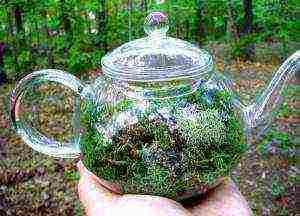
An example of design in a teapot
Any glass container is suitable for growing, for example: a crystal vase, a transparent bowl, an aquarium, a bottle, a jar. It should be remembered that:
- The thickness of the glass must be sufficient so that it does not burst under the load of soil and plants.
- There must be a "door" or a lid, since to maintain the microclimate it will be necessary to cover the top of the container with them.
- Plants must be selected so that they need increased air humidity, and they should not exceed 20 cm in size.
That is, the following are suitable: calathea, fern-like plants, fittonia, codiaums or crotons, arrowroots, dieffenbachia, trefoil or alocasia, plunok or selaginella, calamus, rheo, its other name is “Moses in a basket”. Shade-tolerant plants, such as begonia, moss, artillery plant or pilea, feel good in the vessel.
It is not necessary to grow cacti in transparent vessels, as with excess moisture they will grow poorly. Exceptions can only be made for rainforest cacti.
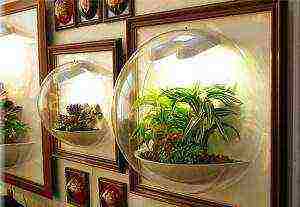
An example of a landing on the wall
Drainage is placed at the very bottom of the container: coarse sand, expanded clay, small pebbles. After the bottom is decorated, that is, they put beautiful shells, pebbles, foil, driftwood, glass.
The added soil may contain leaves, sand, peat, but fertilizers should not be poured into it, otherwise plants and flowers will grow very quickly and look undecorated.
Before placing the plants, the soil and the vessel are poured with boiling water and dried thoroughly, then there will be no pathogenic microbes in the container. Plants are grown in containers with soil for about 1.5 years. If you grow flowers in a hydrogel, their lifespan is reduced to 6 months.
Before planting the plant, you need to determine where to place the vessel: if it is close to the wall, then it is best to place the smallest details in front, and the tall ones farther away. Although for good plant growth, it is necessary to turn it towards the light source, so it is better to place them like this: the tallest plants are in the center, the lowest plants are at the edges.
You can plant plants directly in the ground or place them in pots, carefully decorating them with moss, colored soil, and shells. Plants are placed spaciously so that they grow freely, do not crowd each other. Plants are placed in one container, selecting those species that have the same requirements for moisture and soil composition and for illumination.
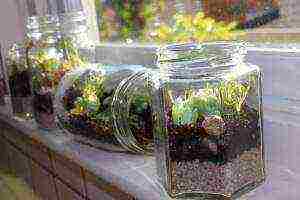
Glass containers on the windowsill
Plants are best placed in small pots covered with moss. This is the easiest way to replace a wilted plant. If you decide on a similar planting, then first fill in some of the expanded clay, then put the pots, and at the end, pour the expanded clay again.
If you want to grow orchids, then they need to be placed in orchidariums - these are special transparent containers with heating, a barometer. They are sold in stores.
Orchids are quite capricious, they need a low temperature at night, certain lighting, adherence to a constantly low, but not freezing temperature in winter.
Growing a garden in containers does not take much time, and the result pleases the grower for a long time.
Features of growing in large vessels
For a container with a wide opening, you can use the tools used to care for indoor plants.
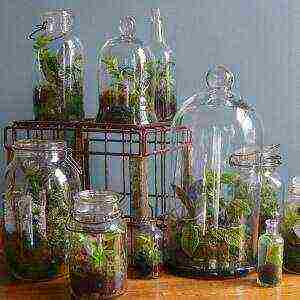
Plants in transparent vessels
Abundantly flowering plants such as rhododendrons or azaleas, cyclamens, chameleon flowers or episodes, uzambara violets can rot in closed vessels, so they are grown exclusively in large containers and are often ventilated.
Drainage should take up 1/3 of the total soil. Pour a layer of soil about 3 cm on top, it depends on the height of the plant and the volume of the vessel.
Plants need to be periodically inspected, weeds removed. If the plants have grown a lot, then cut out unnecessary leaves and shoots. As a rule, after 1 year the plants are planted, and after 3 years they completely replace the soil and the plants themselves. They are watered much less often than usual, since the air in the vessel is more humid than in the apartment.
Features of growing a garden in a bottle
Fern-like plants, miniature begonias, cacti are planted in such a container. Suitable for growing in a bottle: chlorophytum, tiny ficus, ivy, earthen star or cryptantus, vitreous root or arrowroot, saltyrolia, dwarf fern species, begonias, low sansevieria, pilea, fittonia, Rowley's rose flower. If you are looking for plants for planting in a bottle, then choose slow-growing species.
As special tools, they take a spoon and a fork, a plug for compacting the soil, a razor for cutting off wilted leaves. These tools are attached to sticks.

Plants in a glass container
First you need to take a handful of charcoal, pour it through a funnel into a vessel, then pour out soil about 10 cm thick. Charcoal will help to cope with the unpleasant smell of rotting that appears with high humidity.
Gently shake off excess soil from the roots, wrap the plant in paper so as to push it through the neck of the container, then remove the paper. Make small depressions in the ground, first plant larger plants, then those that are smaller. Shake the leaves off the ground and cork the surface of the soil.
Water the plants with a plastic tube. After watering the plants, do not close the bottle until the sides of the bottle are fogged up. Then the container can be closed with a stopper or lid. The moisture will gradually evaporate by the plants, and then flow back down the walls of the bottle.
Growing plants in a bottle does not require large expenses, anyone can afford such a hobby.
When watching the video, you can find out information related to transparent containers, which are called florarium.
So, if you follow certain rules for growing plants in transparent containers, they will delight you every day.
Houseplants
Friends, finally, glass pots have appeared in our city of Belgorod!
Stylish? Yes. Comfortable? Yes. Handsomely? Maybe. BUT…
When I finally got ready to buy one such glass (bright lilac) pot, a lot of questions arose:
1) do they harm the roots of plants (specifically interested in poinsettia, bougainvillea, hatiora, and in general everything except epiphytes, since everyone knows how they feel in transparent pots)?
2) how to ensure that there is no lime on the walls of the pot ?! because it is transparent and SHE (lime) will be visible not only inside, but also outside the pot!
3) aesthetically, will the roots in the EARTH look at all through the glass walls of the pot?
If anyone has experience or opinion on this issue - write. I think none of it will be interesting to me.
Indoor orchids bloom for a long time - up to 8-11 months in a row, but not everyone can enjoy this spectacle. If you gave an orchid in a pot, how to care for it so that the plant becomes a pet for a long time?
Orchid is a delicate, sensitive, beautiful and expensive flower.Many amateur flower growers would like to have it in their collection, but they are afraid that they will not cope with a capricious plant. Caring for an orchid at home requires several prerequisites, which we will talk about today.

An exotic flower in a pot as a gift is a popular idea of recent years, but the givers are never interested in whether the hero of the occasion will be able to cope with the gift. If you have no experience growing indoor plants, our tips will help your present survive.
Tropical capricious
If you have already decided to leave the flower at home for a long time, be prepared to take care of it. Visit a specialty store, purchase the right soil and fertilizer, consult your dealer for feeding frequency and other important considerations on how to care for your potted orchid.
The main condition for caring for orchids is moderation in everything. Frequent watering, direct sunlight, and even changing the location of the pot or turning it around can cause the flowers to shed. So a tropical plant gives signals that a change in conditions is not to its liking.
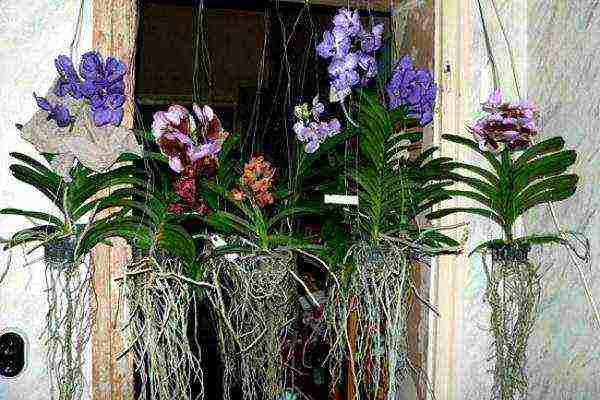
It is better to choose a transparent orchid pot made especially for tropical flowers. It should be remembered where this paradise wondrous flower comes from. His homeland is the tropics. Accordingly, the roots emerge from the soil, absorbing moisture not only from the soil, but even from the air.
Important! Do not try to bury the roots when lifting them - this will damage the health of your pet.
Lighting for good flowering
Remember: if there is little light, the orchid will not bloom. How to determine whether there is enough sun, whether a swollen bud will bloom? This can be understood by the color of the leaves, they usually turn dark green.
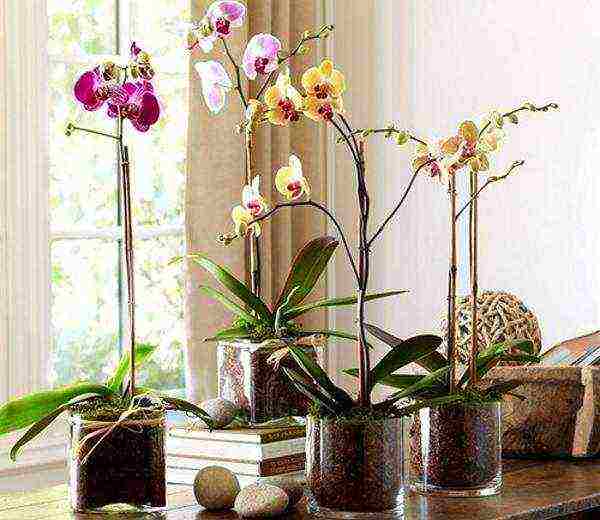
If the leaves of the orchid turn yellow and become covered with dryish dark red spots, then there is too much sun. A window sill on the south side is not the best place for him. It is better to keep the plant on a pedestal or on the floor, where the direct rays of the sun will not reach.
How to water an orchid?
Our compatriots actively communicate in various specialized forums for flower growers. Every second person who received an orchid as a gift complains that her plant has disappeared within a week.
The death of a flower is mainly due to the fact that it is watered the way we are used to dealing with ordinary unpretentious plants. Each type of orchid needs special watering, but the general principle is the same.
Watering orchids is a whole ceremony:
- Place the plant pot carefully in a sink, tub, or basin.
- Water the soil with a gentle shower. Keep the water temperature for irrigation at room temperature.
- When you lift the pot and see water flowing through the holes in the pot, the water has saturated the soil.
- We put the pot in any bowl. When the remaining water drains off, watering is complete. The whole procedure takes 5 to 15 minutes.
Pafiopedilum, Cymbidium, Phalaenopsis and Odontoglossum love slightly damp soil, it is enough to water them once every 3-4 days. The soil for Dendrobium, Oncidium and Cattleya must dry out between waterings, so we water them only 2-3 times a month.
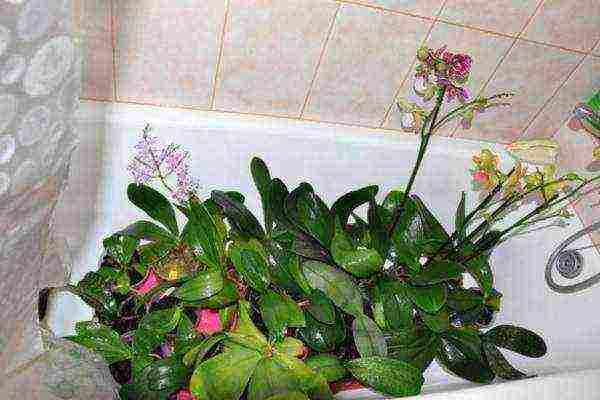
An orchid needs active watering only during the period of active growth, ejection of flower stalks and the beginning of flowering. Several times a year you need to water it with vitamins dissolved in water, which can be purchased in a specialized department for gardeners.
If you think globally, these exotic plants tolerate drought better than excessive moisture. An excess of moisture is the main reason for the rapid extinction of a flower at home. Note that you should water much less frequently in winter than in summer.
Comfort temperature
If the air conditioner works constantly (night and day) in the room, that is, the temperature is constantly from 20 to 25 degrees, then soon the flowers of the plant will be covered with fine wrinkles, and then they will completely fall off. An orchid can "hibernate" and miss several months of flowering.As a result, you will just get a pot with green leaves and sticking out arrows of the peduncles.
An important part of caring for home orchids is temperature change. They feel good at temperatures from +18 to +28 degrees during the daytime and from +12 to +23 at night. It is imperative to maintain the alternation of day and night temperatures. When the temperature changes, the roots of plants rest and gain strength.

Summing up, we note a few of the most important rules on how to care for an orchid in a pot:
- transparent pot - with holes in the bottom;
- special soil and complementary food - the frequency and dosage are detailed on the package with fertilizer for orchids;
- correct watering - it is better to dry out than to pour;
- lighting - do not allow direct rays of the sun;
- temperature - we withstand the difference day-night.
It won't be long before you wake up with a flair for what will be best for your pet. The next step will be the desire to learn how to propagate the plant, so that you yourself have the opportunity to give an orchid that you have grown yourself. Good luck!


